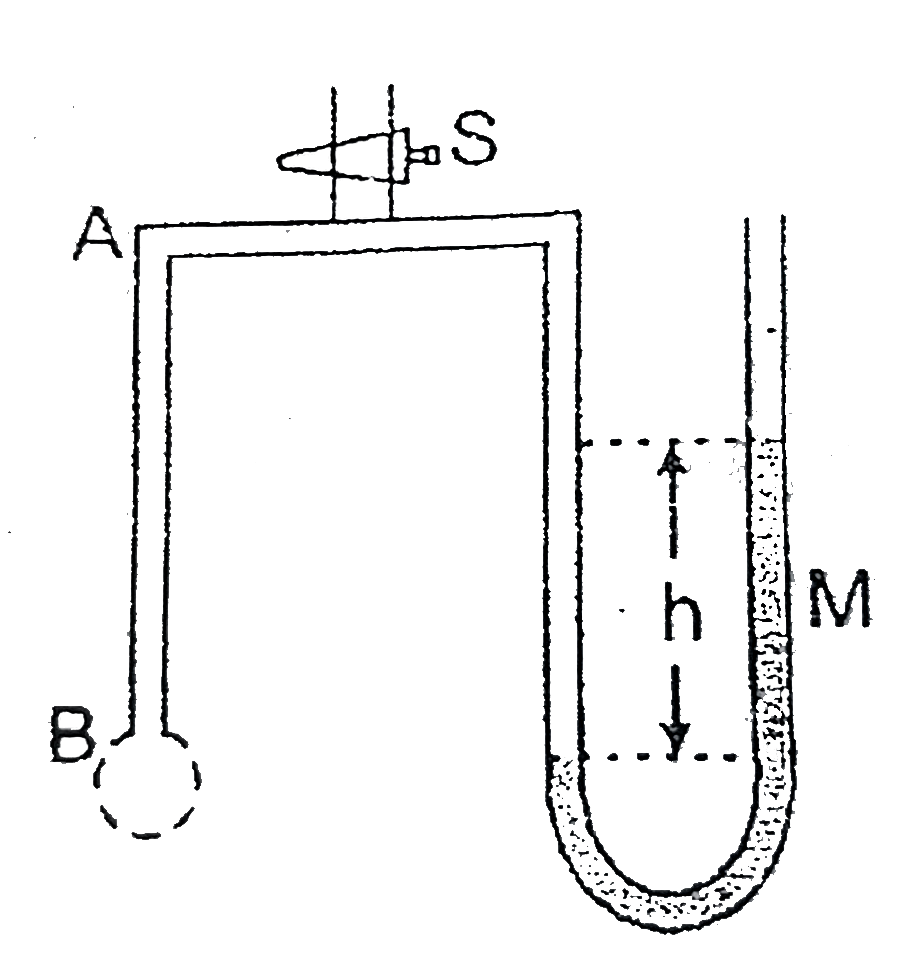Two separate air bubbles (radii 0.002cm and 0.004) formed of the same liquid (surface tension 0.07N/m) come together to form a double bubble. Find the radius and the sense of curvature of the internal film surface common to both the bubbles.
The correct Answer is:D
To solve the problem of finding the radius and the sense of curvature of the internal film surface common to two air bubbles, we will follow these steps:
Step 1: Understand the Problem
We have two air bubbles with radii:
- rA=0.002cm=0.00002m
- rB=0.004cm=0.00004m
Both bubbles are formed in the same liquid with a surface tension T=0.07N/m.
Step 2: Calculate the Excess Pressure in Each Bubble
The excess pressure P inside a bubble is given by the formula:
P=P0+4Tr
Where P0 is the atmospheric pressure (which will cancel out later).
For bubble A:
PA=P0+4TrA=P0+4×0.070.00002
For bubble B:
PB=P0+4TrB=P0+4×0.070.00004
Step 3: Calculate the Excess Pressures
Calculating PA:
PA=P0+0.280.00002=P0+14000Pa
Calculating PB:
PB=P0+0.280.00004=P0+7000Pa
Step 4: Determine the Pressure Difference
Since PA>PB, the pressure difference is:
ΔP=PA−PB=(P0+14000)−(P0+7000)=7000Pa
Step 5: Calculate the Radius of the Common Film Surface
The excess pressure in the film surface common to both bubbles can be expressed as:
P=4Tr
Setting this equal to the pressure difference:
4Tr=7000
Substituting T=0.07:
4×0.07r=7000
Solving for r:
r=4×0.077000=0.287000≈0.00004m=0.004cm
Step 6: Determine the Sense of Curvature
The sense of curvature is determined by the relationship between the pressures in the bubbles. Since PA>PB, the internal film surface will be concave towards the smaller bubble (bubble A).
Final Answer
- The radius of the internal film surface is r=0.004cm.
- The sense of curvature is concave towards the smaller bubble.
We have two air bubbles with radii:
- rA=0.002cm=0.00002m
- rB=0.004cm=0.00004m
The excess pressure P inside a bubble is given by the formula:
P=P0+4Tr
Where P0 is the atmospheric pressure (which will cancel out later).
PA=P0+4TrA=P0+4×0.070.00002
PB=P0+4TrB=P0+4×0.070.00004
Calculating PA:
PA=P0+0.280.00002=P0+14000Pa
PB=P0+0.280.00004=P0+7000Pa
Since PA>PB, the pressure difference is:
ΔP=PA−PB=(P0+14000)−(P0+7000)=7000Pa
The excess pressure in the film surface common to both bubbles can be expressed as:
P=4Tr
Setting this equal to the pressure difference:
4Tr=7000
Substituting T=0.07:
4×0.07r=7000
Solving for r:
r=4×0.077000=0.287000≈0.00004m=0.004cm
The sense of curvature is determined by the relationship between the pressures in the bubbles. Since PA>PB, the internal film surface will be concave towards the smaller bubble (bubble A).
- The radius of the internal film surface is r=0.004cm.
- The sense of curvature is concave towards the smaller bubble.
Topper's Solved these Questions
- BOOK - DC PANDEY ENGLISHCHAPTER - FLUID MECHANICSEXERCISE - Solved Examples21videos
FLUID MECHANICS
- BOOK - DC PANDEY ENGLISHCHAPTER - FLUID MECHANICSEXERCISE - Miscellaneous Examples10videos
FLUID MECHANICS
- BOOK - DC PANDEY ENGLISHCHAPTER - EXPERIMENTSEXERCISE - Subjective15videos
EXPERIMENTS
- BOOK - DC PANDEY ENGLISHCHAPTER - GENERAL PHYSICSEXERCISE - INTEGER_TYPE2videos
GENERAL PHYSICS
Similar Questions
Two soap bubbles of radii 2 cm and 4 cm join to form a double bubble in air, then radius of. curvature of interface is
View SolutionTwo identical soap bubbles each of radius r and of the same surface tension T combine to form a new soap bubble of radius R. The two bubbles contain air at the same temperature. If the atmospheric pressure is p0 then find the surface tension T of the soap solution in terms of p0, r and R. Assume process is isothermal.
View Solution
Knowledge Check
- Question 1 - Select One
Two soap bubbles A and B are kept in a closed chamber where the air is maintained at pressure 8N/m2. The radii of bubbles A and B are 2cm and 4cm, respectively. Surface tension of the soap. Water used to make bubbles is 0.04N/m. Find the ratio nB/nA, where nA and nB are the number of moles of air in bubbles A and B respectively. [Neglect the effect of gravity.]
A2B4C6D8
A soap bubble A of radius 0.03 m and another bubble B of radius 0.04 m are brought together, so that the combined bubble has a common interface of radius r, then the value of r is
View SolutionTwo soap bubbles of radii 2 cm and 3 cm are brought in contact. Find the radius of curvature (in cm) of the contact surface.
View SolutionThe surface tension of a soap solution is 2×10−2N/m. To blow a bubble of radius 1cm, the work done is
View SolutionThere is an air bubble of radius 1.0 mm in a liquid of surface tension 0.075Nm−1 and density 1000kgm−3. The bubble is at a depth of 10 cm below the free surface. By what amount is the pressure inside the bubble greater than the atmospheric pressure? Take g=9.8ms−2.
View SolutionA tube of fine bore AB is connected to a manomeer M as shown. The stop cock S controls the flow in air. AB is dipped into a liquid whosw surface tension is σ. On opening the stop cock for a while, a bubble is formed at B and the manometer level is recorded, showing a difference h in the levels in the two arms. If ρ be the density of manometer liquid and r the radius of curvature of the bubble, then the surface tension σ of the liquid is given by
 View Solution
View SolutionTwo soap bubbles of radii a and b coalesce to form a single bubble of radius c. If the external pressure is P, find the surface tension of the soap solution.
View SolutionThere is an air bubble of radius 1.0mm in a liquid of surface tension 0.075Nm−1 and density 103kgm−3. The bubble is at a depth of 10.0cm below the free surface of a liquid. By what amount is the pressure inside the bubble greater than the atmospheric pressure?
View Solution

